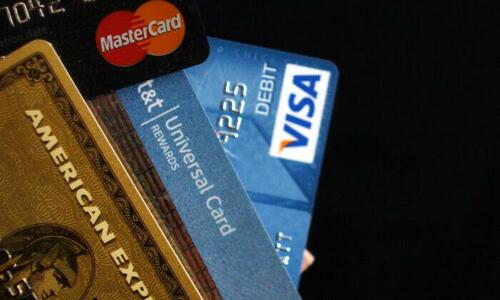Average Credit-Card Debt Soars By 13%, Largest Increase Since 1999
Authored by Bryan Jung via The Epoch Times,
The average credit card debt held by households in the United States surged by 13 percent in the second quarter, the largest increase in such debt since 1999, according to an Aug. 30 report from the Federal Reserve Bank of New York.
More consumers are increasingly relying on credit amid sky-high inflation in order to pay their bills.
Credit card balances increased by $46 billion from last year, becoming the second-biggest source of overall debt last quarter, though it is below pre-pandemic levels.
Meanwhile, the current credit card interest rate is now at a record high of 17.96 percent, according to Bankrate, a financial advice website.
American Households Are Falling into Debt
Total American household debt rose by $312 billion from the second quarter of 2021 for a total of $16.15 trillion at the end of June 2022.
This is a 2 percent rise from the year-ago quarter, largely due to a jump in mortgage rates, and car loan and credit card balances, caused by40-year high inflation, said Joelle Scally, a New York Fed analyst, in a statement.
The Federal Reserve is attempting to fight inflation by raising interest rates, causing fears that its aggressive moves may encourage a bad recession, as the economy recovers from the pandemic.
“The second quarter of 2022 showed robust increases in mortgage, auto loan, and credit card balances, driven in part by rising prices,” said Scally, who reviews microeconomic data at the central bank branch.
Household debt balances are about $2 trillion higher than they were at the end of 2019, before the start of the pandemic, as the price of goods and services have skyrocketed.
“‘Bidenflation’ is wreaking havoc on American families’ finances. Credit card debt is rapidly rising,” wrote Rep. Lloyd Smucker (R-Pa.) in a tweet.
Mortgage balances, which have fueled much of the increase in debt, rose in the second quarter, climbing by $207 billion, to $11.39 trillion.
A consequence of this is that there are 35,000 people facing new foreclosures on their credit reports, a jump of more than 45 percent from the previous quarter.
This is still below the 100,000 foreclosures before the pandemic, due to a moratorium prohibiting the repossession of homes during the period.
The hike in interest rates since March of this year had caused mortgage rates to rise, leading to a decline in growth in the housing sector.
Auto loans rose by $33 billion, to $199 billion, while student loan balances remained relatively the same as last year.
Student loan payments have been on hold since the pandemic, but were set to resume on Sept. 1.
President Joe Biden has made student loan forgiveness one of his major issues for the fall midterm elections—an act that has divided much of the country.
In total, non-housing balances in the second quarter increased by $103 billion, or 2.4 percent over the first quarter, the largest quarterly increase in six years.
Delinquency Rates Are About to Get Worse
“While household balance sheets overall appear to be in a strong position, we are seeing rising delinquencies among subprime and low-income borrowers with rates approaching pre-pandemic levels,” said Scally.
Researchers at the New York Fed, in a separate blog post last month, warned that the historically low delinquency rates appear to be coming to an end.
The 30-day delinquency rate rose, from 1.66 to 1.81 percent in the second quarter of 2022, according to the latest delinquency data from the Federal Reserve.
Delinquency rates among areas of the country with the lowest average income rose 2.5 percent from roughly 2 percent last year.
“With the supportive policies of the pandemic mostly in the past, there are pockets of borrowers who are beginning to show some distress on their debt,” the researchers said, noting that “the delinquency transition rates for credit cards and auto loans are creeping up, particularly in lower-income areas.”
The central bank researchers said that delinquencies are “rising modestly” across all debt types and is worse among low-income borrowers.
However, Scally believes that average household finances appear to be in a strong position at this time.
https://ift.tt/GRc7kAr
from ZeroHedge News https://ift.tt/GRc7kAr
via IFTTT






0 comments
Post a Comment